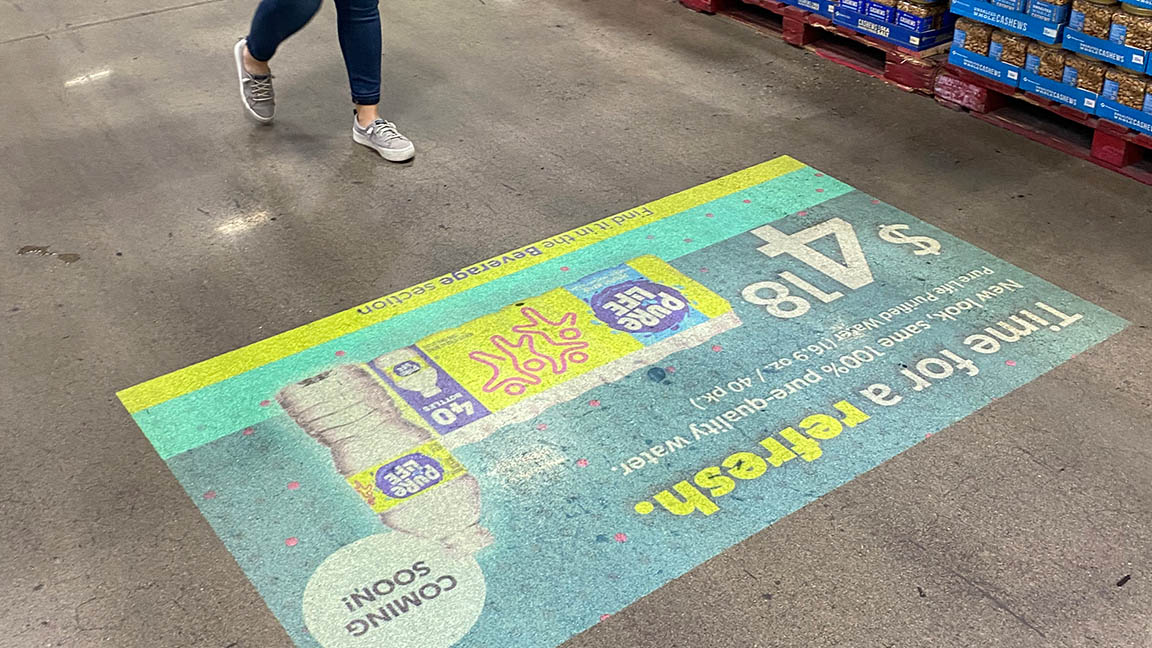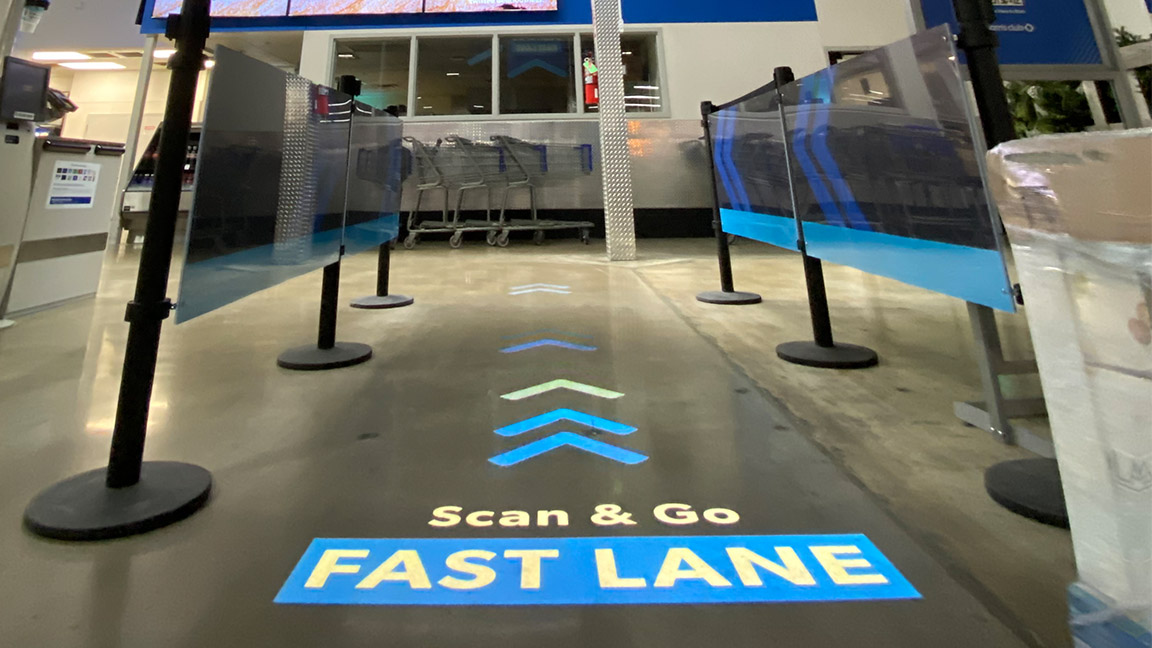Watch Where You’re Walking
Floor projection hits big-box retail with dynamic messaging.

Delivering the unexpected can be a winning marketing strategy when executed well. But the art of surprising consumers extends beyond traditional creative methods like standard digital signage and video. Sometimes the winning twist can be a clever way of reaching them.
Across the retail landscape, the largest block of untapped marketing real estate is right under their feet. Wovenmedia, a San Francisco-based digital signage firm, working in conjunction with projection specialist Sharp/NEC, is now rolling out dynamic marketing and messaging in retail environments using laser floor projection systems.

“Part of the strategy behind floor graphics is trying to utilize sales space that typically or historically isn’t utilized to engage shoppers in a new way from an advertising standpoint,” said Drew Walls, a strategic account manager at Wovenmedia specializing in big-box retail. Major retailers are now taking advantage of floor real estate for advertising just as consumers return to their aisles in big numbers.
In-Store Experience Impact
"When we went through the pandemic, the first thing to really suffer from a retail standpoint was the in-store experience," Walls explained. "It completely changed how people shopped. As we look forward to getting people back in a retail setting, and continuing their customer journeys within a retail environment, I think there’s a desire to reassess how they’re being engaged and how that in-store experience can be enriched."
A clear advantage of floor projection over other in-store marketing methods is that it disrupts the retail shopping experience and redirects shoppers’ attention. “If you’re pushing your cart, you can’t really help but stop and pay attention,” Walls said. “I think it’s also a case study in how we can effectively disrupt that journey. You’re trying to get them used to seeing information and receiving ads in a new way.”
Today, consumers are conditioned to look for display monitors to find useful information in public settings, such as a schedule of arrivals and departures at an airport or an electronic menu board at a deli. Those constraints are not an issue with floor projection.
“You can get very creative with the content in doing this projection mapping, which is totally different than what you could do using … your typical flat panel.”
John Moezzi, Sharp/NEC
“Typically, what you’re going to see, as far as an electronic display, is a large-format, flat-screen monitor that’s in your typical 16:9 aspect ratio—the all-familiar rectangle that you see,” said John Moezzi, national accounts manager at Sharp/NEC. “With this technology, we can do all sorts of things. We don’t have to project a rectangle down on the floor.”
A daily selection of the top stories for AV integrators, resellers and consultants. Sign up below.

Through projection mapping techniques, static images or dynamic video projected onto the floor appear in their own shapes and sizes by essentially removing the negative space from the visual assets. In a retail environment, the result could be a special sales message from a brand for that particular location or a general brand commercial.
“With creative uses of the content, you can do all sorts of things that look completely out of the ordinary,” Moezzi said. “Let’s say you use a black background—when you shoot black down onto the floor, it doesn’t show anything. So, if you imagine having a video with bubbles going across the screen, all you would see on the floor is bubbles. You can get very creative with the content in doing this projection mapping, which is totally different than what you could do using a large-format display, your typical flat panel.”
Laser Power
Moezzi credits the advent of widespread laser projection with enabling floor projection in retail. Although the concept of floor projection had been proven with bulb projectors, he said scaling to multiple locations—300 stores to date in the case of one big-box retailer—required the ease of maintenance afforded by laser projectors.

“The laser light source never has to be changed, unlike a lamp that you have to change after so many hours,” Moezzi explained. “Also very important is the optical block is sealed. With lamp-based technology, you would have a filter that has to be cleaned after so many hours to prevent dust from causing problems with the display of the images. Given the fact that there’s no lamp to replace or filter to clean, these laser projectors are essentially maintenance free.”
[So, You Want to Do Projection Mapping!]
That level of hands-off operation is crucial for executing a successful floor projection installation, Moezzi said. With the projectors mounted to ceiling rafters high above the sales floor, a motorized lift is needed to access them for maintenance (or replacement in the case of laser projectors). Interrupting the shopping journey to perform regular maintenance on overhead projectors isn’t high on retailers’ wish lists.
“We had to think through every possible scenario we could to try to mitigate any risk,” Moezzi offered. “You want to do everything you can to remotely remediate any issues that there might be, as well as proactively do the things that are required so that you don’t have issues pop up in the first place.”
Read the Room
Environmental challenges can determine where to place floor projection by narrowing the field of potential locations. Installed overhead lighting, as well as ambient sources such as skylights, can be gating issues for the designers and installers behind floor projection installations.
“From a technical aspect, the physical location is pretty important when you’re trying to execute these projectors, simply because you’re going to run into considerations like lighting in different retail settings,” Walls said. “Every store is going to have different lighting conditions. There’s just going to be tweaking that you’re gonna have to do, such as brightness [and] coming up with the best mix for maximum visibility within a setting that might have ambient light already.”
[Projection Mapping Transforms the Clocktower in the Mile High City]
Floor projection assets can be uploaded, scheduled, and implemented on site in the retail store or at a corporate headquarters—in this case using the WovenManager CMS with Projector Control Application in conjunction with NEC NP-P605UL laser projectors.
“Where are we going to place these, as it relates to high-traffic items that are the most profitable [and whose] ads speak the most relevantly to?” Walls asked. “I think, looking forward, location is really going to be a driving factor in adding more projectors or especially how these will serve more of a wayfinding and a human purpose. And that just completely depends on the strategy from a retail standpoint.”
Wayfinding could be a natural application of floor projection once marketers establish them as a source of information. For now, however, retailers are mostly using the technology to boost sell-through of products in their stores.
“Retailers have had an interest in this sort of application for a long time, but the technology was just not there,” Moezzi said. “This is an example of the technology meeting a need that retailers already had, so they’re very receptive to the idea of trying an application like this.”
Jim Beaugez is a freelance writer and content creator for the AV, professional audio, and music industries. His work has been published by Systems Contractor News, Pro Sound News, Mix, Radio World, and The Recording Academy, as well as Rolling Stone, Smithsonian, Guitar World, Guitar Player, and other consumer publications. He previously worked in communications for the pro audio and musical instruments industries.
